Foot Rot in cattle and sheep / goats
Local names:
Luo: achany, abok / Borana & Gabbra: okol, bargao / Kipsigis: moeet / Gikuyu: rugumo / Maasai: Alelei, en jalan / Maragoli: bulwaye vwe tsimbagayu / Samburu: ngojini, namurie / Somali: raaf-dila, rafqarir, gumeed, rafdilnac, rafjac, bog, boog / Turkana: ekichodinu, ebaibai /
Common names: foul-in-the-foot, pietin, pietur (French), pedero (Spanish)
Introduction
Following periods of prolonged rain, outbreaks of foot rot appear in cattle, sheep and goats, even those kept under extensive production systems. Humid, warm conditions favour the organisms responsible. Foot rot can be a major disease problem under intensive dairy production systems, especially when zero-grazing is practised.
Other factors such as breed and housing are known to influence the occurrence and severity of the disease. Under intensive systems where exotic breeds are kept, the disease occurrence is more severe than in extensive systems where most indigenous breeds are normally kept.
The disease has negative economic consequences to the farmer because it hinders the animal from feeding at the time when there is plenty of good feed. Serious foot problems reduce the productive life-span of the dairy cow, which has to be culled too early.
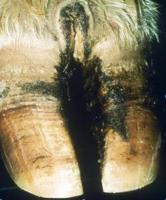 |
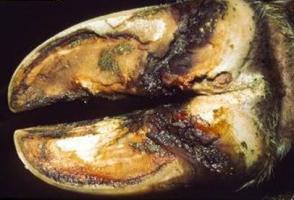 |
| Foot Rot | Foot Rot |
|
© Dr. Paul R. Greenough Reproduced from the Animal Health and Production Compendium, 2007 Edition. CAB International, Wallingford.
|
© Dr. Paul R. Greenough Reproduced from the Animal Health and Production Compendium, 2007 Edition. CAB International, Wallingford. |
a) Foot Rot in Cattle
In cattle different bacteria are involved in foot rot, the most important one being Fusobacterium. These bacteria are also present in faeces, which explains why the disease is more common in dirty environment and is also difficult to control.
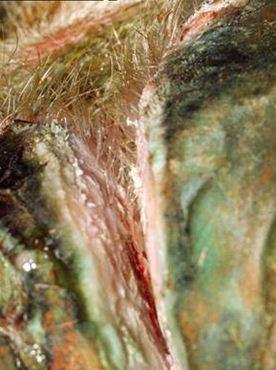 |
| Signs of Foot Rot - Separation between hooves and bone |
|
© Dr. Paul R. Greenough Reproduced from the Animal Health and Production Compendium, 2007 Edition. CAB International, Wallingford.
|
Causes
The bacteria causing foot rot are normal residents of the environment of cattle but cannot penetrate healthy skin. Any injury to the foot and especially to the skin between the toes provides an entry for foot rot bacteria and allows these pathogens to infect the skin and the tissue underneath the skin. Injury occurs easier and more frequently in skin that has been softened by constant exposure to water, faeces and urine.
The animals contract the disease when they walk in wet, muddy places which have been contaminated by animals with foot rot.
Adult cattle are more commonly affected than younger animals and local breeds of cattle appear to more resistant than those of European breeds.
Signs of Foot Rot in Cattle
- A wound in the inter-digital skin (see picture) becomes infected causing local inflammation
- The infection then spreads causing a bigger lesion which becomes smelly and oozes pus
- Typically the infection also spreads into the claws and causes separation between the hooves and the bone, the animal stops putting weight on that foot, later the hooves weaken and begin to peel off, pus oozes out which has a foul smell.
- Even the joint above the hooves can become infected
- The disease causes severe pain, severe lameness, fever, loss of appetite, loss of condition and reduced milk production and may force the owner to cull the animal
- The condition usually starts in one cow and slowly spreads to other animals
- Usually one limb only is affected
Diseases with similar symptoms
Leg and feet lesions: see Foot and Mouth Disease
Prevention
- Keep the ground clean and dry, especially in zero grazing(!), you can use saw dust to keep the surface dry
- If you have concrete surface make sure the surface is very even and smooth - uneven and rough concrete surface causes injury to the hooves
- Frequently clean, sweep and scrape hard surfaces free of manure; remove dung and mud from the boma regularly
- Drain areas around drinking troughs, gateways and frequented tracks.
- Trim hooves regularly, any overgrowth should be cut off when you see it, always keep the hooves in normal shape
- Cows with soft hooves are more likely to suffer from foot rot, do not buy or keep offspring from such cows
Treatment
Treatment must begin as soon as possible!
- If there is already a large lesion, wash the foot especially the skin between the claws with hot water- as hot as you can put your hand in; then apply an antiseptic solution like dettol or similar; cut away or trim any decayed part of the hoof to remove the infection that is underneath it, remove all dead tissue using a clean pen-knife; treat surface with Hydrogen Peroxide 3% and cover with a wound powder/ointment (e.g. copper sulphate in the form of a blue paste); make sure the animal is kept on dry clean surface
Caution: when trimming the hooves inexperienced people may cut too deep causing extra injury - it is very good to watch an experienced stockman trimming hooves and learn from him
- After operating on the foot supportive treatment with antibiotics is necessary: good results are obtained with Procaine-Penicillin or Penicillin-Streptomycin IM for 3 days at double the normally recommended dose; long-acting Oxytetracycline also gives good results as does a three day course of Trimethroprim/Sulphadaizine IM
Common traditional practices
- Somali: Wash the foot with very salty water repeatedly until the animal recovers
(Source:ITDG and IIRR 1996)
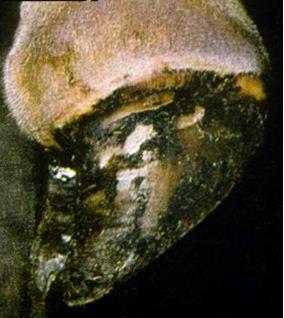 |
| Painful swelling of foot |
|
© Dr. Paul R. Greenough Reproduced from the Animal Health and Production Compendium, 2007 Edition. CAB International, Wallingford.
|
b) Foot Rot in Sheep/Goats
In sheep/goats Foot Rot is a serious herd problem that can affect many sheep/goats and spread rapidly through the entire flock. In most cases more than one foot is affected.
Causes
In Foot Rot two organisms are required to start the infection - Fusobacterium necrophorum and Dichelobacter nodosus. Fusobacterium lives in the sheep's guts and environment and can also affect cattle. Fusobacterium alone cannot cause Foot Rot. Dichelobacter lives only in the affected hooves of carrier sheep/goats and is the main cause for foot rot. During rainy Dichelobacter can survive for maximum two weeks on soil or pasture and infect more sheep/goats. Foot Rot is transmitted via the contaminated environment. If healthy sheep/goats share pasture, watering points and/or the boma with Foot Rot infected sheep/goats they pick up the infection while passing through contaminated areas
Signs
- In sheep/goats the first sign is mild lameness
- When examining the feet of a sheep/goats in the early stage of Foot Rot you can see inflammation of the skin between the hooves
- In more advanced cases the infection begins to spread into the hoof and parts of the hoof begin to separate from the bone, separation spreads under the sole and finally the outer wall so that the horny hoof starts to come off. The dead tissue has a characteristic smell
- Severe Foot Rot causes the sheep/goat to loose its' hooves and walk on its knees while feeding
- Sheep/goats lose condition, rams stop to serve, meat, wool and milk production is down; because ewes and does have too little milk to support the lambs/kids many of them die
- The whole hoof may come off, the sheep/goats cannot stand up any more, maggots may invade infected areas and the sheep/goat has to be culled.
Prevention & Control
- If foot rot affects a flock on wet pasture immediately move the animals to drier places.
- For controlling Foot Rot keep sheep/goats in footbath containing a 10% zinc sulfate solution (10% is 100 grams per one liter of water); adding a little bit of laundry detergent (e.g. Omo) improves the effectiveness of the footbath; the sheep/goats have to remain standing in the foot bath for 1 hour. If no zinc sulfate is available you can also use 10% copper sulphate solution or 5% formaldehyde solution for the foot bath; in this case sheep/goats only remain in the footbath for 5-10minutes.
- The small liquid foot bath in picture above consists of a plastic tray lined with a 5-cm thick layer of foam plastic. The foam is covered by a stout plastic sheet. The tray contains a medicated fluid. As the animal walks on the surface, the foam and plastic are depressed and the liquid flows in. The swirling action of the liquid brings affected tissue into contact with the medication.
- The footbath should be repeated every 5-10 days for 3 treatments.
- Regarding sheep/goats any sheep added to the flock must be examined for evidence of Foot Rot and if lesions are found these sheep should either be treated and isolated for a month, or rejected.
- All sheep and goats in the flock must be treated at the same time and any which do not respond to treatment should be culled.
- Alternatively two flocks should be created - a clean flock and one separate from the group with no foot lesions; examine all feet at least once every two weeks
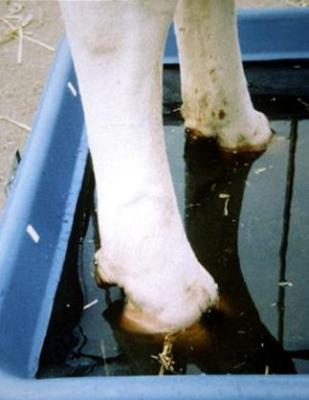 |
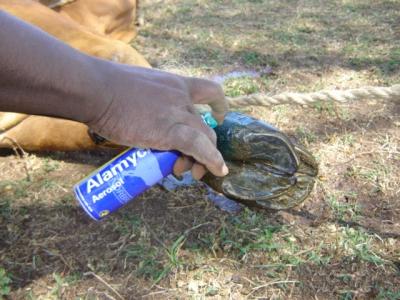 |
| Prevention and Control of foot rot | Application of aerosol spray to cure fot rot |
|
© Dr. Paul R. Greenough Reproduced from the Animal Health and Production Compendium, 2007 Edition. CAB International, Wallingford.
|
© William Ayako, Kari
|
Treatment
- Careful examination of all feet; all loose dead material on the hooves and any overgrowth must be trimmed using a clean pen knife, this should be done before putting sheep/goats through the footbath
- Caution: when trimming the hooves inexperienced people may cut too deep causing extra injury - it is very good to watch an experienced herder trimming hooves and learn from him
- In addition Penicillin/Streptomycin given IM at double the recommended dose for three days is effective
The success of any treatment is much greater if the sheep are kept in a completely dry environment after treatment. The feet of treated sheep should be examined every 1-2 weeks to identify those needing further treatment.
Diseases with similar signs/symptoms
- Foot abscesses in sheep/goats. These abscesses are caused by injury of the skin just above the hooves. The injury results from sharp objects like sharp thorns and hard stubbles. This disease leads to lameness in many animals, but affects mostly only one foot. When examining the affected foot a localized abscess containing pus is visible on the skin above the rim of the hoof. This abscess may be very deep and even affect the joint. But unlike Foot Rot the foot abscesses do not affect the hooves and do not cause the hoof to come off. Early treatment with antibiotic injections is often effective and may prevent joint infection. Once the infection becomes established in the joint, treatment is very difficult.
- FMD
- Bluetongue can also cause mass lameness in sheep/goats.
